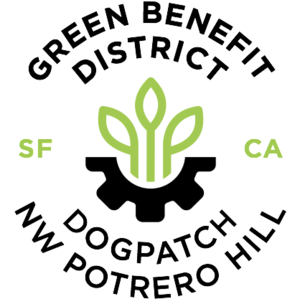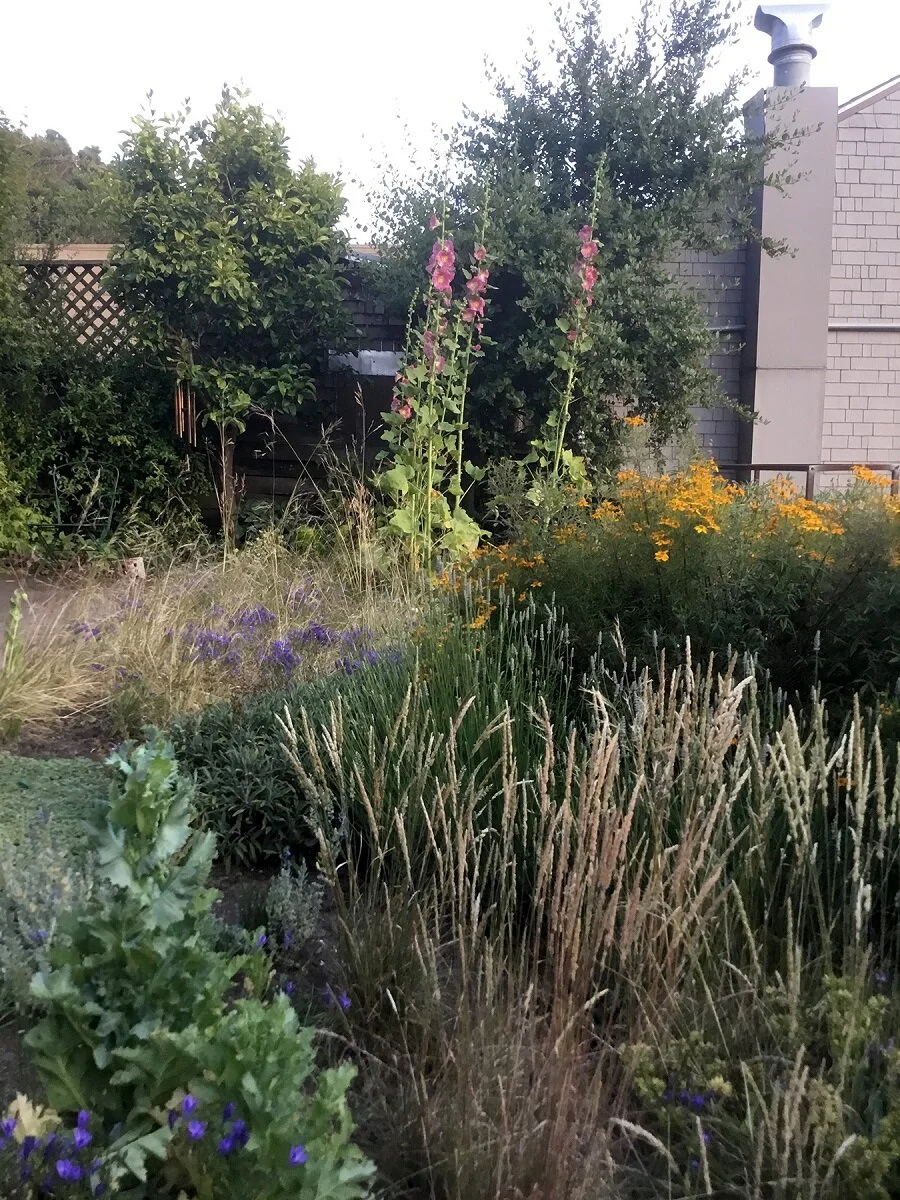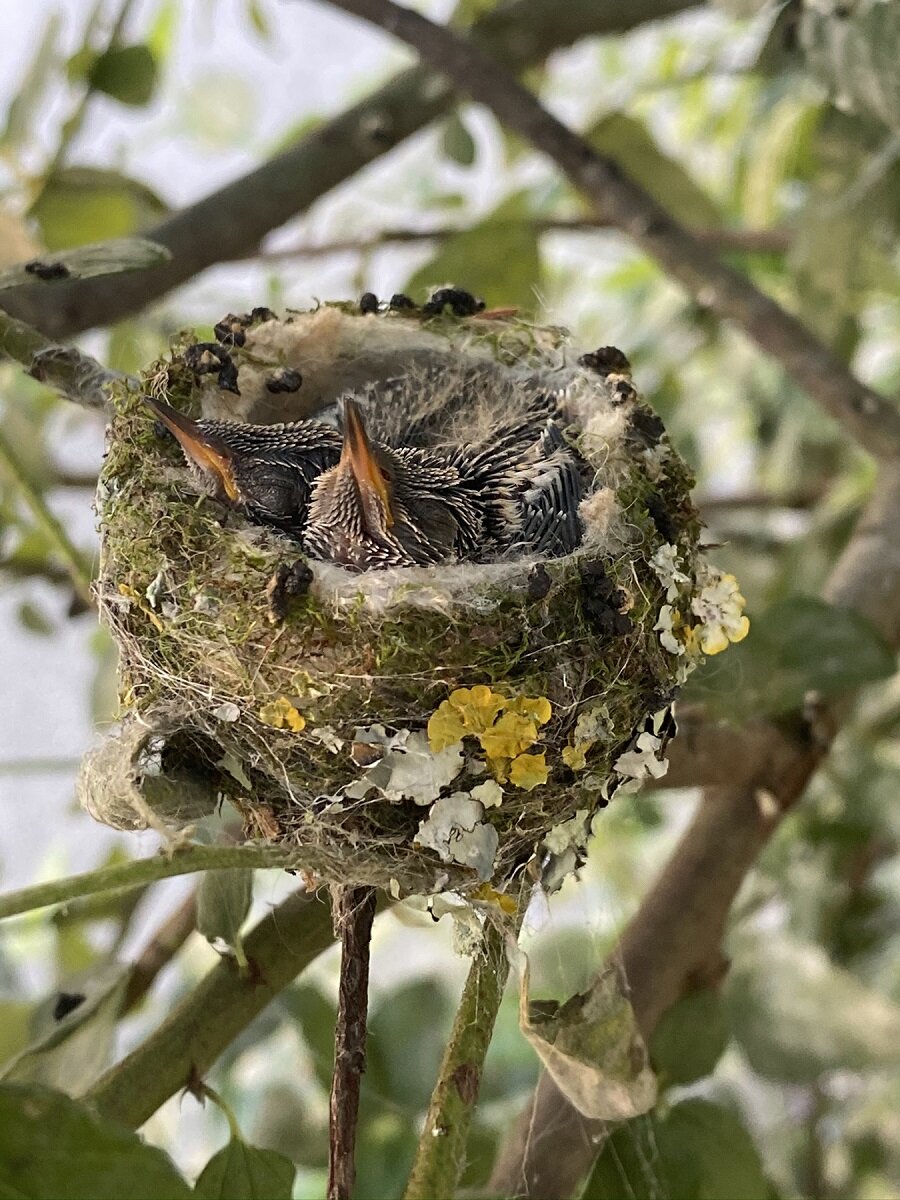An Interview with Landscape Architect Terri McFarland
Foreground, left: Stipa pulchra (Purple needlegrass) in early winter. Background: CA native shrub Salvia mellifera (Black sage) in sky with assorted Mediterranean shrubs
Why use California native grasses in garden design? The easiest answer is our native grasses are beautiful! Adapted to our dry summers, they are a good low- or no-water choice for gardens. As a garden designer, I use grasses as a canvas upon which to compose showy drifts of flowers. On larger properties, restoration of native meadows can be an economical and appropriate understory for dry shade under oaks. Sweeping meadows draped over rolling landforms is a beloved feature of California.
As a professional landscape architect, I want to help tell the story of our native grasslands which according to the California Native Grasslands Association are among the most important yet most endangered ecosystems in the United States. The “oak savannah” is the quintessential California landscape, but today few pristine prairies remain due to development, poorly managed grazing, fire suppression, and exotic species. The ecological benefits of grasslands include erosion control, water recharge, biodiversity, habitat, and carbon capture.
The theory of “shifting baselines” posits that humans accept the degradation of ecosystems from generation to generation as the original baseline gets forgotten. If we don’t know what a healthy ecosystem looks like, how can we restore it? Gardeners who care for these species in home gardens, perhaps as a “museum” of endangered species, can help support the mission of CNGA to promote, preserve, and restore the diversity of California’s native grasses and grassland ecosystems. The resilience of our grasslands will be an essential component for adapting to climate change.
Spent flower stalks of Stipa pulchra (Purple needlegrass) with purple blooms of Triteleia laxa (Ithuriel’s spear)
What are the challenges of using native grasses in a garden? Weed control is the number one challenge when trying to establish native grasses. European annual grasses are very successful in out competing our native species. Even before these introduced species took over, indigenous persons used controlled burns to maintain open grasslands for grazing elks. Fire, grazing and meadows evolved together. Today, some ranches are having good success using cows to restore native grasslands, timing their grazing for exotic weed control. In a small backyard garden, an attentive gardener can easily manage weeds by hand-pulling. I have gotten very adept at distinguishing a weed from a native sprout by subtle differences in the shade of green or texture.
Another challenge is the dormant period which gardeners may think look “dead” rather than dormant. The grasses can be kept greener with irrigation, but I enjoy them in all phases. One strategy is to set dryer grasses within evergreen plants. I’m not a purist, and I also enjoy plants from other Mediterranean climates such as the classics - lavender, rosemary, sage. I also can’t resist lovely summer annuals such as zinnias, sunflowers, cosmos and poppies which keep the summer garden vibrant. While appreciating the ecological story of native grasslands, as a designer I use grasses as I would any other plant in my garden, placing them to show off the particular charms of each species.
Foreground: CA native Koeleria micrantha (Junegrass) Background: CA natives Stipa pulchra (Purple needlegrass) + Triteleia laxa (Ithuriel’s spear) with non-native Hollyhocks and Mexican Marigold
How much water do you use and how is it distributed? A big advantage of using California native grasses is that they are adapted for our dry summers, and once established, you won’t need to irrigate at all. California is called the “Golden State” for the color of dry grasslands. In your home garden, you can keep these grasses green with extra water, but I like to embrace the season cycles, and honor the plant’s adaptations. Having very deep roots to carry plants through dry periods has another important ecological benefit, that of carbon sequestration. Unlike burning forests which release tons of carbon into the atmosphere, burning grasslands keep most of their biomass in deep roots underground, and can quickly regenerate.
The “needles” of Stipa pulchra (Purple needlegrass) blowing in the wind. These will self-sow in the garden.
How long since your grasses have been planted? Were they from seed or from a nursery? I started using native grasses in my garden in 2003 with plugs of Stipa lepida (Foothill needlegrass) leftover from Quintessa Winery, a project in Napa Valley that I worked on with Lutsko Associates. This project restored an oak savannah that wraps the winery and includes native grass meadows on the roofs. These are still going strong in my garden with minimal if any summer water.
Over time, I’ve planted additional grass species from both seeds and plugs, sourced from Hedgerow Farms in Winters or Larner’s Seeds in Bolinas. Lately, I’ve been harvesting my own seeds for the magic of the seed-to-seed cycle. In addition to diversifying the grass species, I’ve been adding flowering native perennials. I was so pleased this spring when the first blooms of Aquilegia formosa (Western columbine) showed up 3 years after sowing.
CA native perennial wildflowers: Pink flowers of Sidalcea malviflora (Checkerbloom) w/ creamy white flowers of Erysimum concinnum (Point Reyes Wallflower) within green straps of Triteleia laxa (Ithuriel’s spear) and Stipa pulchra (Purple needlegrass)
Have you thought about native varieties that span the year so that every season has a different bloom?The joy of tending a garden is to connect more deeply with time, and to be fully present to life. I tap into this biophilia as I watch the sequence of grasses, beginning in winter with Stipa pulchra (Purple needlegrass) greening up with the first bit of rain. Early spring features the delicate flowers of Koeleria micrantha (Junegrass) one of my favorites with its soft blue-green foliage. Next come spikes of Festuca idahoensis (Idaho fescue) the most lawn-like of our natives. I also love the seeds of the melics (Melica californica, Melica torreyana) which look like metallic beads glowing in the shadier part of my garden. Another favorite moment is when the purple flowers of Triteleia laxa (Ithuriel’s Spear) nestle into the spent flower stalks of Stipa pulchra.
Baby hummingbirds nesting in CA native Ceanothus ‘Ray Hartman’ (California lilac)
What fauna have you observed? I have seen many birds, butterflies, and bees visit my garden. This spring, two hummingbirds hatched in the Ceanothus ‘Ray Hartman’ (California Lilac). On foggy mornings, I find cute little native bees napping in the sticky yellow flowers of Grindelia camporum (Central Valley Gum plant.) On “butterfly TV” last month, I saw about 10 butterflies floating between my and my neighbor’s yard, when a noisy mockingbird jumped on the fence angling to catch an orange Gulf fritillary. He missed, and all the butterflies immediately hid themselves. Seed-eating birds, such as California towhee, junco, golden crown sparrow or finch, stop by in fall to peck at grass seeds fallen in the soil. I’ve come to see the fauna as another design element in my garden – if I can make a little bird happy and fat, I’m doing something right!
Species list [partial] for Terri’s Potrero Hill garden:
California native perennial wildflowers:Achillea millefolium (White Yarrow)
Aquilegia formosa (Western columbine)
Asclepias fascicularis (Narrow-leaf milkweed)
Eschscholzia californica (California poppy)
Erysimum concinnum (Point Reyes Wallflower)
Grindelia camporum (Central Valley Gum plant)
Sidalcea malvilflora (Checkerbloom)
Sidalcea calycosa rhizomata (Pt. Reyes checkerbloom)
Sisyrinchium bellum (Blue-eyed grass)
Thalictrum fendleri (Foothill meadow rue)
Triteleia laxa (Ithuriel’s spear)
California native perennial bunchgrasses:
Festuca californica (California fescue)
Festuca idahoensis (Idaho fescue)
Koeleria micrantha (Junegrass)
Melica californica (California melic)
Melica torreyana (Torrey melic)
Stipa lepida (Foothill needlegrass)
Stipa pulchra (Purple needlegrass)
Resources:
California Native Grasslands Association: www.cnga.org
California Native Plant Society: www.cnps.org
Hedgerow Farms: www.hedgerowfarms.com
Larner’s Seeds: www.larnerseeds.com
Terri McFarland is a Green Advocate Director on the Dogpatch-Northwest Potrero Hill Green Benefit District Board and serves on the GBD’s Biodiversity Committee. A California licensed landscape architect, she has been tending her garden in Potrero Hill since 1992. She worked for 18 years as a principal landscape architect at Lutsko Associates, a San Francisco-based firm known for using California native plants in contemporary design. She opened her solo practice in 2019, and teaches advanced landscape design classes at Merritt College in Oakland.






